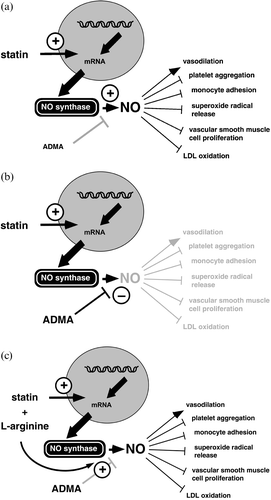Figures & data
Figure 1. Schematic overview of biochemical pathways related to ADMA. Methylation of arginine residues within proteins or polypeptides occurs through N‐methyltransferases, which utilize S‐adenosylmethionine as a methyl group donor. After proteolytic breakdown of proteins, free ADMA is present in cytoplasm. It can also be detected circulating in human blood plasma. ADMA acts as an inhibitor of NO synthase by competing with the substrate of this enzyme, L‐arginine, and causes endothelial dysfunction and – subsequently – atherosclerosis. ADMA is eliminated from the body via urinary excretion and, alternatively, via metabolism by the enzyme dimethylarginine dimethylaminohydrolase (DDAH) to citrulline and dimethylamine. Reproduced from Citation17.

Table I. Pathophysiological conditions in which ADMA was reported to be elevated.
Figure 2. Results from prospective clinical studies that have assessed ADMA as a risk marker. Data represent hazard ratios(boxes) and 95% confidence intervals (horizontal lines) for the comparison of the highest ADMA stratum with the reference group.

Figure 3. ADMA may modify the statins' therapeutic effects. Statins are suggested to exert at least part of their vascular protective effects via upregulation of NO synthase gene expression (a). In the presence of high circulating ADMA levels, upregulation of the eNOS's gene by statins may still result in functionally inactive enzyme, since it is inhibited by ADMA (b). Excess exogenous L‐arginine may overcome inhibition by ADMA and thus restore the statins' effects on endothelial function (c). Reproduced from Citation75.
